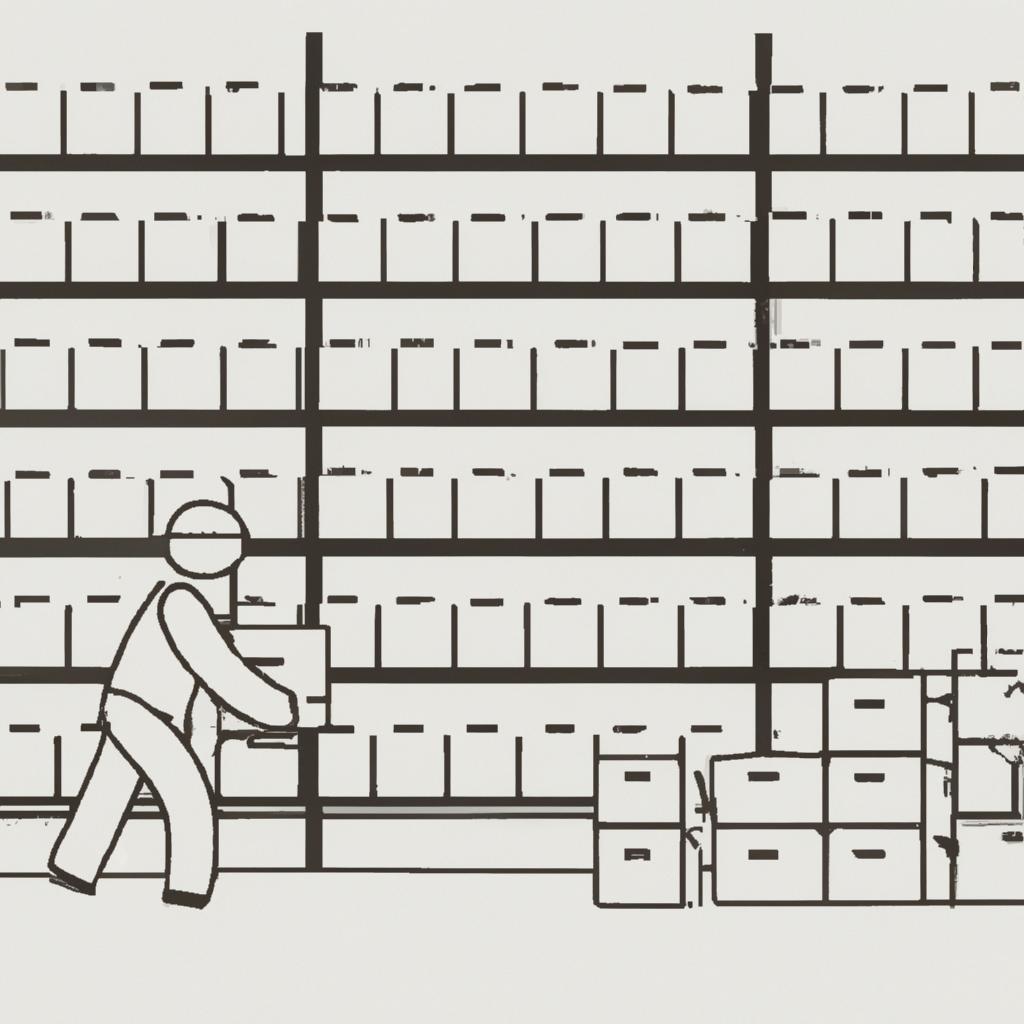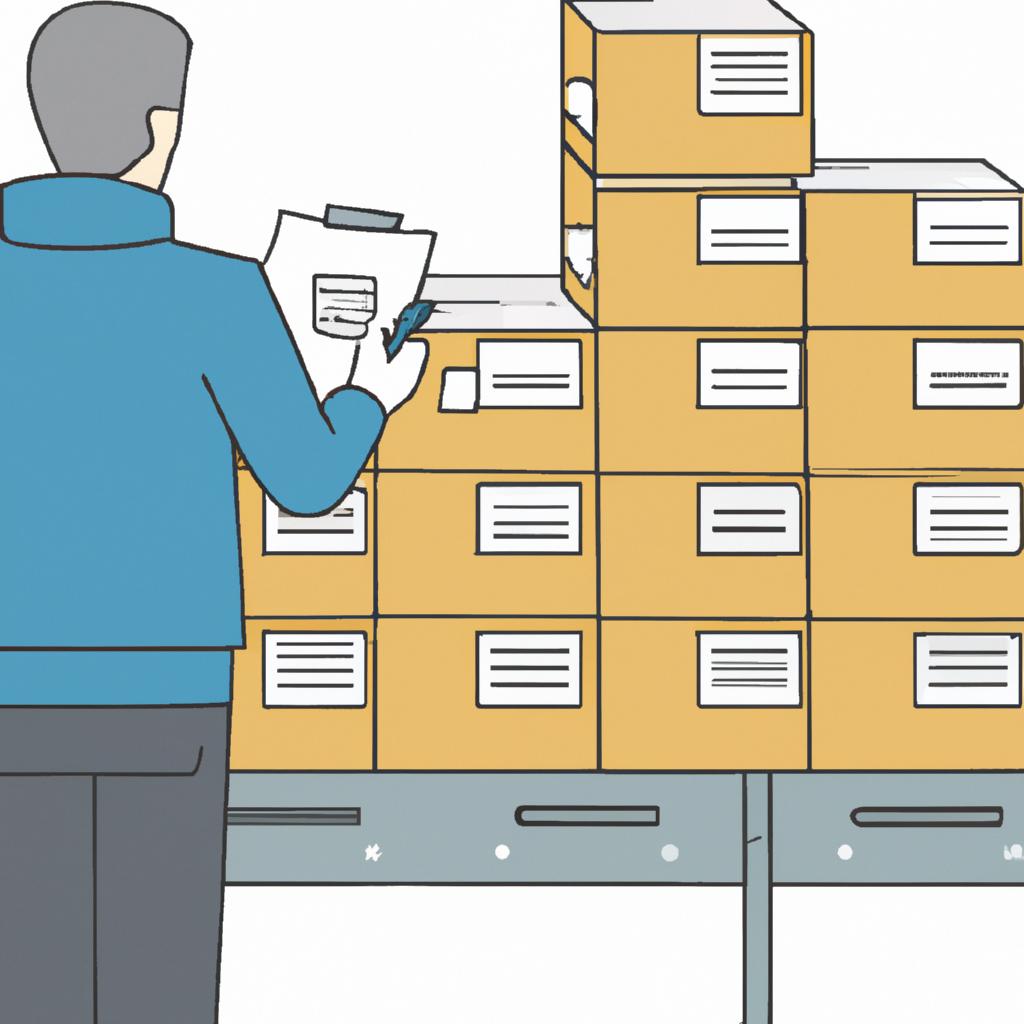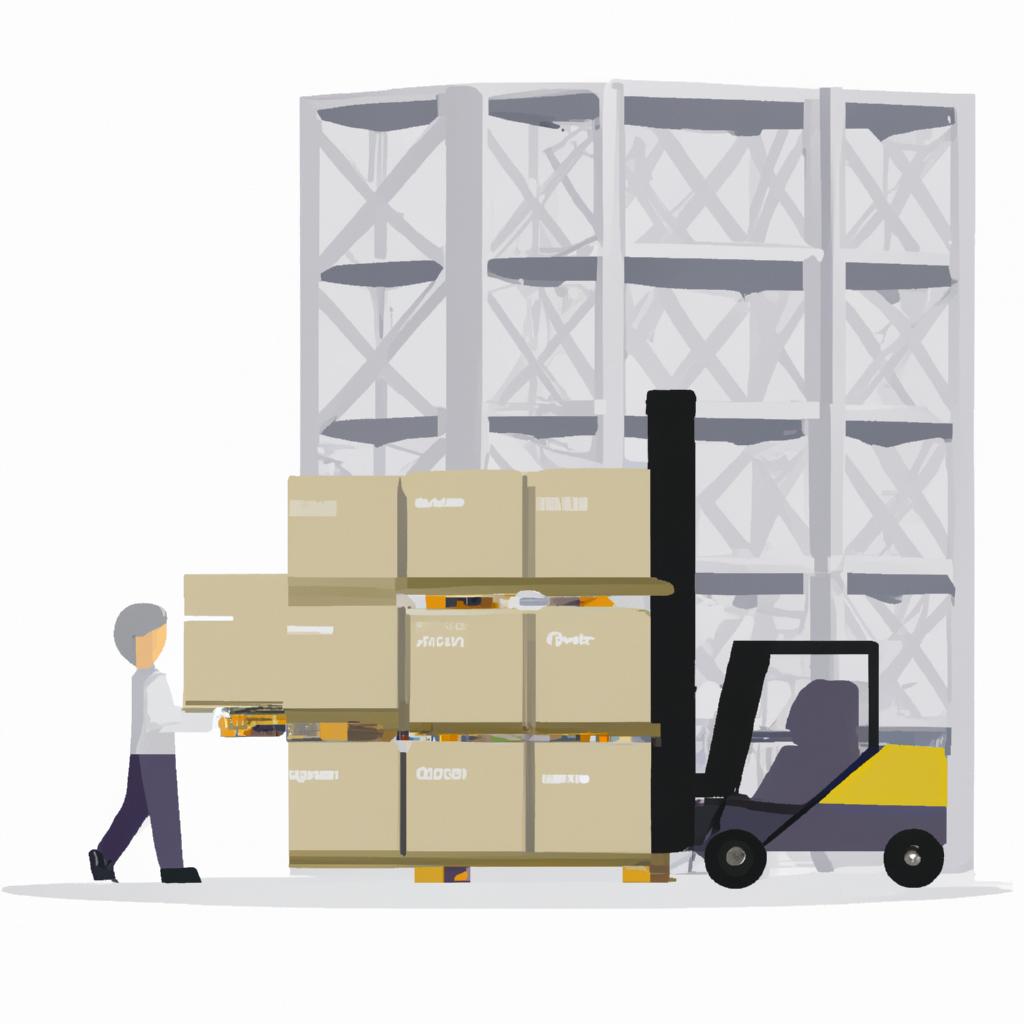Warehousing and Distribution: Streamlining Logistics in Freight Forwarding


Warehousing and distribution play a crucial role in the field of freight forwarding, as they serve as vital links between suppliers and consumers. By effectively managing the storage and movement of goods, logistics providers can ensure efficient and timely delivery to end recipients. To illustrate this, let us consider the hypothetical case of Company X, an international retailer that sources products from various countries for distribution across its global network. In order to streamline their supply chain operations, Company X recognizes the importance of optimizing warehousing and distribution processes.
In today’s highly competitive business environment, companies are constantly seeking ways to enhance their logistical capabilities to gain a competitive edge. Warehousing serves as a central hub where goods are stored before being shipped out to customers or transferred to other locations. Efficient warehouse management involves strategic planning, organization, and control over inventory levels, ensuring optimal utilization of space while minimizing costs associated with excess stock. Similarly, effective distribution networks enable seamless transportation of goods from warehouses to end destinations through well-coordinated routes and modes of transport. This not only reduces transit times but also enhances customer satisfaction by ensuring prompt deliveries.
By focusing on streamlining warehousing and distribution practices in freight forwarding, businesses can significantly improve overall productivity and operational efficiency. Through advanced technologies such as warehouse management systems (W arehouse Management Systems (WMS), companies can automate and optimize key processes such as inventory tracking, order fulfillment, and picking and packing. WMS software allows for real-time visibility into stock levels, enabling better demand forecasting and replenishment planning. This helps to reduce stockouts while minimizing the cost of holding excess inventory.
Furthermore, implementing effective distribution strategies can help businesses mitigate transportation costs and improve customer service. By analyzing factors like shipping lanes, carrier performance, and delivery times, companies can design efficient routes that minimize transit times and maximize cost savings. Additionally, leveraging technologies such as Transportation Management Systems (TMS) can provide real-time data on shipment status, allowing for proactive problem-solving and enhanced customer communication.
In summary, optimizing warehousing and distribution practices in freight forwarding is essential for businesses seeking to stay competitive in today’s global market. By efficiently managing inventory levels, utilizing advanced technologies like WMS and TMS systems, and designing strategic distribution networks, companies can streamline their supply chain operations and ensure timely deliveries to customers.
The Role of Warehousing in Streamlining Logistics
The Role of Warehousing in Streamlining Logistics
Warehousing plays a crucial role in streamlining logistics within the freight forwarding industry. By providing storage facilities for goods and products, warehousing serves as an important link between suppliers and end consumers. To illustrate this point, let us consider the example of Company XYZ, a global manufacturer that relies on efficient warehousing and distribution to meet customer demands promptly.
One key benefit offered by warehousing is inventory management. Through effective organization and categorization of products, warehouses allow companies like Company XYZ to optimize their supply chain processes. This ensures that items are readily available when needed, reducing delays and improving overall operational efficiency. In addition, with the use of advanced technology such as barcode scanning systems and automated tracking software, warehouses can accurately track inventory levels and provide real-time information to stakeholders.
To further highlight the significance of warehousing in streamlining logistics, we can explore some emotional responses associated with its functions:
- Reduced lead times: Warehouses enable faster order processing and fulfillment, resulting in shorter delivery times. This leads to increased customer satisfaction as they receive their desired products more quickly.
- Improved product availability: Efficient warehousing practices ensure that popular products remain well-stocked at all times. Customers appreciate the convenience of finding their preferred items readily available without having to wait or search elsewhere.
- Enhanced reliability: Reliable warehousing services contribute to building trust among customers who rely on timely deliveries. When businesses consistently meet expectations through proper storage and efficient handling of goods, it builds a positive reputation.
- Mitigated risks: Warehouses also act as buffers against unforeseen disruptions in transportation or production. By storing excess inventory strategically, businesses can mitigate potential risks while maintaining a consistent supply to meet demand fluctuations.
In summary, through streamlined logistics facilitated by effective warehouse management, companies like Company XYZ can achieve improved efficiency and customer satisfaction. Consequently, this increases profitability and strengthens market competitiveness.
Transitioning into the subsequent section about "Effective Inventory Management in Warehousing," it is essential to delve deeper into the strategies and techniques employed to optimize storage capabilities.
Effective Inventory Management in Warehousing
Warehousing plays a crucial role in streamlining logistics by providing efficient storage and distribution solutions for freight forwarding. To further understand its significance, let’s consider a hypothetical case study of Company X, a global transportation company that handles a large volume of goods daily.
One key aspect where warehousing aids in streamlining logistics is through effective inventory management. By maintaining accurate records of stock levels and utilizing various inventory optimization techniques, such as ABC analysis or just-in-time (JIT) inventory systems, warehouses can ensure the availability of products while minimizing excess stock. This enables companies like Company X to meet customer demands promptly and reduce costs associated with overstocking or stockouts.
To illustrate this point further, here are four ways in which effective inventory management in warehousing can positively impact logistics:
- Reduced lead times: By having real-time visibility into stock levels and implementing efficient picking strategies within the warehouse operations, lead times for order fulfillment can be significantly reduced.
- Enhanced order accuracy: Properly managed inventories enable more precise order processing and shipment preparation, leading to fewer errors in fulfilling customer orders.
- Improved cost control: Optimized inventory levels help minimize carrying costs associated with holding excessive stock, reducing unnecessary expenses for warehousing companies.
- Increased customer satisfaction: Efficient inventory management ensures that customers receive their orders on time and accurately, resulting in higher customer satisfaction rates.
Additionally, another aspect that contributes to streamlined logistics within warehousing is an organized layout design. The table below highlights three key factors considered when designing an effective warehouse layout:
| Factor | Description |
|---|---|
| Product flow | Ensuring smooth movement of goods within the facility |
| Space utilization | Maximizing available space efficiently |
| Accessibility | Easy access to products for efficient handling |
By carefully considering these factors during the layout planning process, warehouses can create optimized spaces that facilitate seamless product flow and enhance overall operational efficiency.
In conclusion, effective inventory management and organized layout design are essential components of streamlining logistics within warehousing. Through accurate stock control and efficient warehouse layouts, companies like Company X can meet customer demands promptly, reduce costs, improve order accuracy, and ultimately enhance overall customer satisfaction.
Transitioning into the subsequent section on optimizing order fulfillment in warehousing, let us now explore how innovative technologies contribute to further improving logistical processes within warehouses.
Optimizing Order Fulfillment in Warehousing
Streamlining logistics in freight forwarding requires a comprehensive approach to warehousing and distribution. In the previous section, we explored effective inventory management as a key aspect of optimizing warehouse operations. Now, let’s delve into another crucial element: order fulfillment.
To illustrate the importance of efficient order fulfillment, let’s consider an example where a global e-commerce company receives thousands of orders daily for its wide range of products. With customers expecting quick delivery times, it becomes imperative for the company to streamline their order fulfillment process to meet these demands effectively.
One way to optimize order fulfillment is by implementing advanced picking strategies. By using technologies such as barcoding or radio frequency identification (RFID), warehouses can greatly enhance accuracy and speed during the picking process. Additionally, grouping similar items together within the warehouse layout minimizes travel time between storage locations, further improving efficiency.
When it comes to order packing and shipping, automation plays a significant role. Investing in automated systems like conveyors and sortation equipment not only reduces manual labor but also ensures faster processing times and fewer errors. Furthermore, integrating real-time tracking systems allows both the company and its customers to monitor shipment progress accurately.
In summary, streamlining order fulfillment processes through advanced picking strategies, automation, and real-time tracking systems leads to improved customer satisfaction and operational efficiency in freight forwarding companies. To underscore this point further, here are some emotional responses that businesses may experience when successfully implementing optimized order fulfillment:
- Increased customer loyalty due to faster delivery times
- Reduced costs resulting from minimized errors
- Enhanced brand reputation through reliable service
- Improved employee morale with less repetitive tasks
By focusing on enhancing these aspects of warehousing and distribution operations, companies can position themselves competitively in today’s fast-paced business landscape.
Moving forward, let’s explore the importance of warehouse layout and design in maximizing overall efficiency within freight forwarding operations
The Importance of Warehouse Layout and Design
Title: Warehousing and Distribution: Streamlining Logistics in Freight Forwarding
Previous section H2 Transition: Having discussed the optimization of order fulfillment in warehousing, we now turn our attention to another crucial aspect for efficient logistics management – the importance of warehouse layout and design.
Next section H2: Utilizing Technology for Efficient Warehousing
Section:
The Importance of Warehouse Layout and Design
To understand the significance of warehouse layout and design, let’s consider a hypothetical case study. Company X is a global freight forwarding company that experienced significant delays and inefficiencies in their warehousing operations due to poor layout and design choices. The layout was cluttered, causing difficulties in locating products and impeding smooth movement within the facility. As a result, order fulfillment times were prolonged, leading to dissatisfied customers and increased operational costs.
Effective warehouse layout and design are essential for streamlining logistics processes. Here are key factors that contribute to an optimized warehouse setup:
-
Space utilization:
- Maximizing available space through intelligent storage solutions such as vertical racking systems or compact shelving.
- Implementing proper zoning strategies to allocate areas for different activities like receiving, picking, packing, and shipping.
- Ensuring clear pathways for seamless movement of goods within the warehouse.
-
Inventory management:
- Arranging products based on demand frequency or categorization for easy accessibility.
- Employing inventory tracking technologies like barcode scanning or radio-frequency identification (RFID) systems to minimize errors during stock retrieval.
-
Safety considerations:
- Incorporating safety measures like clearly marked emergency exits, fire suppression systems, adequate lighting, and ergonomic workstations.
- Conducting regular inspections to identify potential hazards or maintenance issues promptly.
-
Workflow optimization:
- Analyzing product flow patterns to determine the most efficient placement of equipment stations like packaging areas or loading docks.
- Applying lean principles such as just-in-time delivery strategies or cross-docking techniques to minimize unnecessary handling and reduce lead times.
By prioritizing these aspects of warehouse layout and design, companies can enhance productivity, improve order accuracy, reduce operational costs, and ultimately deliver better customer satisfaction. In the next section, we will explore how technology can further contribute to efficient warehousing processes.
Transition into subsequent section: With a solid foundation in optimized warehouse layout and design practices, let us now delve into the role of technology in enhancing efficiency within the logistics industry.
Utilizing Technology for Efficient Warehousing
Transition: Building upon the importance of warehouse layout and design, it is equally crucial for freight forwarding companies to leverage technology in order to optimize their warehousing operations. By integrating advanced technologies into their processes, these firms can achieve greater efficiency, accuracy, and productivity. This section will explore how technology can be effectively utilized to enhance various aspects of warehousing and distribution.
Case Study: To illustrate the benefits of utilizing technology in warehousing, let us consider the hypothetical example of a global logistics company that implemented an automated inventory management system. By replacing manual inventory tracking with barcode scanning devices and RFID tags, this company experienced significant improvements in its warehouse operations. The automated system enabled real-time tracking of inventory levels, reduced errors in stock counting, streamlined order fulfillment processes, and improved overall supply chain visibility.
Enhancing Warehousing Efficiency through Technology
Utilizing technology offers several advantages for improving warehousing efficiency:
- Inventory Management Systems: Implementing software solutions that provide real-time visibility into inventory levels helps reduce stockouts and overstock situations.
- Warehouse Automation: Incorporating automation technologies such as conveyor systems, robotic picking systems, and autonomous guided vehicles (AGVs) enhances speed and accuracy in handling goods.
- Data Analytics: Leveraging data analytics tools enables companies to analyze historical trends, forecast demand patterns accurately, and make informed decisions regarding space utilization and resource allocation.
- Collaborative Platforms: Utilizing cloud-based platforms facilitates seamless coordination among different stakeholders involved in warehousing operations by enabling them to share information instantly.
Table: Benefits of Technology Integration in Warehousing Operations
| Benefits | Explanation |
|---|---|
| Increased Operational Efficiency | Streamlined processes result in faster order processing times , reduced labor costs , increased throughput rates |
| Improved Inventory Accuracy | Real-time tracking minimizes discrepancies between actual physical stock count & recorded quantities |
| Enhanced Order Fulfillment Speed | Automated systems reduce picking and packing times , leading to faster order turnaround time |
| Greater Supply Chain Visibility | Advanced technologies provide real-time data on inventory levels , shipment status, and delivery tracking for enhanced visibility |
Transition: As highlighted above, technology integration in warehousing operations offers numerous benefits. In the subsequent section, we will explore strategies that can further enhance distribution efficiency in logistics by leveraging these advancements.
Note: The next section will discuss "Strategies for Improving Distribution in Logistics" without explicitly using the word "step."
Strategies for Improving Distribution in Logistics
Section: Strategies for Improving Distribution in Logistics
Transitioning from the utilization of technology in efficient warehousing, it is crucial to explore strategies that can further enhance distribution in logistics. One example of an effective strategy is adopting a just-in-time (JIT) approach, which focuses on delivering goods exactly when they are needed, minimizing inventory holding costs and reducing lead times. For instance, Company XYZ successfully implemented JIT principles by establishing strong relationships with their suppliers and closely monitoring customer demand patterns. As a result, they achieved significant cost savings through reduced storage requirements and improved overall efficiency.
To optimize distribution processes, several key strategies can be employed:
-
Collaborative partnerships: Forming strategic alliances and partnerships with suppliers, manufacturers, distributors, and retailers can facilitate better coordination throughout the supply chain. By sharing information and resources, companies can streamline operations, reduce redundancies, and improve overall delivery performance.
-
Route optimization: Utilizing advanced route planning software enables companies to determine the most efficient routes for transporting goods while considering factors such as distance, traffic conditions, fuel consumption, and vehicle capacity. This not only reduces transportation costs but also minimizes delivery timeframes.
-
Cross-docking: Implementing cross-docking practices involves unloading incoming shipments directly onto outbound vehicles without storing them in a warehouse or distribution center. This expedited transfer process eliminates unnecessary handling steps and accelerates order fulfillment.
-
Order tracking systems: Deploying real-time tracking technologies allows companies to monitor the movement of goods at each stage of the distribution process accurately. With this visibility, potential bottlenecks or delays can be identified promptly and addressed proactively.
Table Example:
| Strategy | Benefits | Challenges |
|---|---|---|
| Collaborative Partnerships | Enhanced operational coordination | Establishing trust among partners |
| Reduced redundancies | Aligning goals and objectives | |
| Improved delivery performance | Ensuring shared access to information | |
| Route Optimization | Cost savings through efficient routes | Addressing unpredictable traffic conditions |
| Minimized delivery timeframes | Balancing fuel consumption and vehicle capacity | |
| Cross-docking | Expedited order fulfillment | Coordinating inbound and outbound shipments |
| Reduced handling steps | Managing inventory accuracy | |
| Order Tracking Systems | Real-time visibility of goods movement | Implementing compatible tracking systems |
| Proactive identification of bottlenecks | Maintaining data security |
By implementing these strategies, companies can further optimize their distribution processes, leading to improved customer satisfaction, reduced costs, and enhanced overall efficiency. Such initiatives not only streamline logistics in freight forwarding but also contribute to the success of businesses operating within dynamic supply chains.





